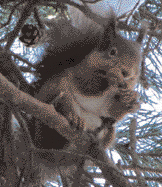| Dalkey Tidy Towns |
  |
| Dalkey Tidy Towns |
  |
|
Wildlife
Newsletter for the Township of Dalkey February 2011 - Michael Ryan |
|
WALES
AND DOLPHINS Nobody needs to be reminded of the record subzero temperatures, dangerous looking icicles and deep snow but within four weeks from mid December to mid January we had some other interesting natural spectacles. The shortest day of the year on 21st December was heralded in by a lunar eclipse. On the east coast we had very good conditions and great views. We watched the early views of the shadow appearing as we walked round the hills though the temperature decided we watched the final stages through the window at home. A few weeks later we had a partial eclipse of the sun. The morning had been a bit overcast and cloudy but at the right moment a strip of clear sky over the horizon appeared as the sun rose. You had to be careful looking at it through shielded squinting eyes and I felt a bit dazed for a while afterwards but the sharp black shadow was clearly visible. Anyone who regularly goes over Dalkey and Killiney hills knows that on rare days you can see the mountains of Wales silhouetted on the eastern horizon. |
 Lunar Escipse over Torka Photo: M. Ryan |
| Sometimes they’re seen early on spring or summer mornings as they’re backlit by the red glow before sunrise and sometimes they can be seen on cold still winter days when the sky is overcast and the light is brightest near the horizon. You get to recognise the rounded mountain looking like a island towards the south while a long mountain range lies further north, the highest peak visible presumably being Snowdonia. Early on the 2nd January a cloudless horizon displayed a few dark shapes but as we looked through binoculars I saw something I’d never seen before. |
| Our snow was long gone but behind the lower darker hills and mountains on the horizon could be seen a range of mountains still covered in snow looming above the sea like Arctic glaciers. The views were even better from the obelisk on Killiney hill. I’ve increased the contrast on the attached photograph since they looked a bit faint but otherwise they’re as we saw them. In four weeks of unprecedented events this was another one for the records. |  Snowdonia
and other Welsh mountains Snowdonia
and other Welsh mountains |
|
CELEBRITY
SWIMMER |
 Red Squirrel Photo: M. Ryan |
| The
photograph, taken by Dalkey resident, John Fahy (for more photographs see
www.dalkeyphotos.com), showed the dolphin breaching, leaping clean out of
the water, with a snow covered Dalkey Island in the background. I believe
the photograph has been syndicated and has appeared all over the world since
it first appeared and probably seen by hundreds of thousands if not millions
of people. Anyhow, the dolphin featured was almost certainly one of the group
of three that have been seen regularly between Dun Laoghaire and Greystones
and were now swimming around below us. Totally oblivious of their celebrity
the dolphins surfaced, dived and probably fed below the surface. Somebody
passing by wondered might they have given each other anything for Christmas?
We reckoned if they had there might have been fish involved. Every time we
started to move off the dolphins would resurface and it seemed shameful to
walk away from such a lovely sight so we were grateful to them when after
at least 90 minutes they did swim on. In the middle of the sub zero temperatures with deep snow on every surface you’d wonder how any birds that normally feed on the ground could survive. Flocks of birds would be coming to feeders they were already familiar with but for other birds it must have been disastrous. Blackbirds were taking slices of apples but many birds were moving around trying to find natural food on trees and bushes. Certainly I’ve never seen a better demonstration of the value of berry and seed bearing plants and trees. Our ‘palm’ trees,(cordyline australi), possibly the most unnatural looking trees to have in eastern Ireland gardens being native of New Zealand. They shed long leathery leaves all year round covering lawns after any high winds and you could spend hours every week picking them up. I’ve occasionally thought of removing a few of them but they do have one great asset. They produce a profusion of seeds and it was on these seeds I watched a blackbird urgently feeding while deep snow lay on the ground. The seeds are also a very attractive food for blackcaps, wood pigeons, blackbirds, starlings, Mistle Thrushes and song thrushes. The slightly less welcome hooded crows love them as well. Thankfully the crows had left some for the blackbirds. Any other berries in the garden were soon gone as well with the Leycesteria formosa (HimalayanHoneysuckle) providing a great food source for bullfinches and blackcaps. I’ve mentioned this plant before, it’s more commonly known as the Pheasant Berry since it used be grown for those birds on game shooting estates. Leycestaria spreads easily, always a sign of their popularity with birds who spread them by passing or ‘venting’ out the seeds. The cold spell was the first time I’d seen chaffinches eating them a swell. Alder seeds are great for siskins and redpolls and of course the humble ivy still produces berries when they’re long gone off most other bushes. If you want to help your wildlife visitors maybe think of planting a seed or berry producing plant that might save a few little lives in future winters. |